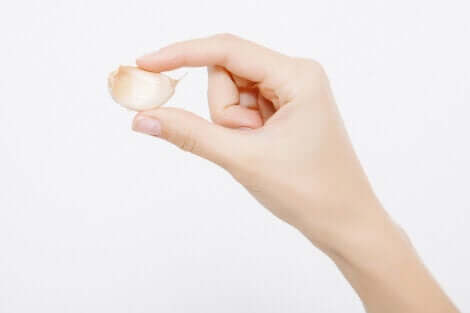Is it Convenient to Use Garlic to Treat Vaginal Yeast Infections?


Written and verified by the doctor Nelton Abdon Ramos Rojas
According to popular beliefs, garlic is a food that can contribute to the treatment of vaginal yeast infections. This is because it’s attributed with antibacterial properties.
However, can it help you meet your goal? Is there a concrete way to take advantage of it so that it provides as many benefits as possible? Discover all the answers below.
The vagina and home remedies, a good combination?
The vagina is a very delicate area of the body that can be affected by various factors, including excessive hygiene. Therefore, you must be careful when trying to improve your health on your own.
Applying a home remedy can be a risky practice, as it can cause irritation and discomfort and also worsen the initial problem.
Neither yogurt, nor the essential oil of a plant or herb, nor garlic can treat or cure vaginal yeast infections. Even when it’s been possible to affirm the opposite in the popular sphere, the home remedies that have been proposed with these ingredients aren’t safe and, instead of contributing to improvement, they can lead to complications.
To treat vaginal yeast correctly, it’s best to go to your doctor and follow their instructions. Additionally, you need to necessary to improve certain habits related to intimate hygiene, hydration, and nutrition. But in no way should you resort to the use of home remedies, such as garlic.
Putting garlic in your vagina ISN’T safe

Not in pasta, nor whole, nor combined with other elements. Garlic isn’t a solution for vaginal yeast infections. There’s no scientific evidence that these remedies work. And, on the other hand, there are cases of people who only have worsened their situation by using it.
American gynecologist Jennifer Gunter decided to explain in very simple terms why you definitely should never put garlic into your vagina:
- Although garlic may have antifungal properties due to its allicin content in labs, this doesn’t mean that it works in mice or a woman’s vagina.
- Garlic can have pathogenic bacteria from the soil that can harm your health. Thus, by putting garlic into your vagina, you’re not eliminating yeast, but promoting further infection.
- Introducing it whole, peeled, or crushed can cause irritation and exacerbate the problem.
Other health professionals from different parts of the world have spoken out on this issue, urging people to forget about using garlic to treat vaginal yeast infections (and other diseases). Instead, they advise following their doctor’s instructions.
Discover: Remedies for Oral Candidiasis: Natural Alternatives
How to treat vaginal yeast infections
Generally, the treatment of vaginal yeast infections involves taking or applying an antifungal medication for a short period (approximately seven days). It may be a tablet, a cream, an ointment, or a suppository. It all depends on the case.
It’s worth mentioning that some medications require a prescription, which is why you should go to your doctor to get one.
If the problem is severe, the treatment may last for longer, and the dose may be higher. In addition, the doctor may consider it necessary to use both oral and topical medications.
Mayo Clinic experts say that, in certain cases, the doctor may prescribe two or three doses of an antifungal drug that should be taken orally instead of a vaginal treatment.
How to avoid infections
Below, we share some of the measures that can help you maintain good intimate hygiene and, of course, avoid vaginal yeast.
- Avoid wearing tight clothes (underwear, tights, jeans, etc.).
- Avoid douching, immersion baths, and the like (swimming pools, for example).
- Use a mild soap (or a special intimate hygiene soap)
- Always shower after exercising.
- Always wipe from front to back after going to the bathroom to avoid transferring anal bacteria to the vagina (and, consequently, the urinary tract).
- Use clean cotton underwear every day and avoid synthetic fabrics to make sure the area can breathe properly and to avoid creating a warm and humid environment that causes the proliferation of microorganisms.

- When you use tampons and pads, remember to change them frequently and wash the area with water to prevent infection.
- If you went swimming at a beach or pool, avoid leaving on a wet bathing suit for a long time, since moisture can promote the proliferation of fungi and bacteria.
- Don’t use perfume, talcum powder, deodorants, or sprays in your vagina, as they can alter the pH balance.
- Take care of your hygiene before and after sex.
- Stay well-hydrated, eat a balanced diet, and maintain an overall healthy lifestyle.
As you can see, the guidelines are very simple and can be easily integrated into your routine. Therefore, taking care of yourself doesn’t have to be an extraordinary task.
Remember that if you have any questions, you can always consult your trusted gynecologist, as they’ll be able to offer you the best guidance, depending on your concerns, needs, and state of health.
All cited sources were thoroughly reviewed by our team to ensure their quality, reliability, currency, and validity. The bibliography of this article was considered reliable and of academic or scientific accuracy.
- Watson, C. J., Grando, D., Fairley, C. K., Chondros, P., Garland, S. M., Myers, S. P., & Pirotta, M. (2014). The effects of oral garlic on vaginal candida colony counts: A randomised placebo controlled double-blind trial. BJOG: An International Journal of Obstetrics and Gynaecology. https://doi.org/10.1111/1471-0528.12518
This text is provided for informational purposes only and does not replace consultation with a professional. If in doubt, consult your specialist.








